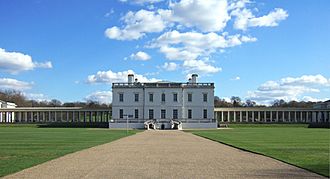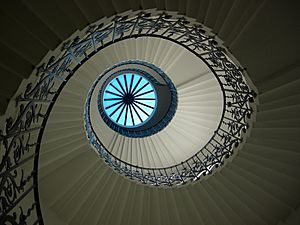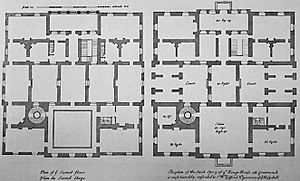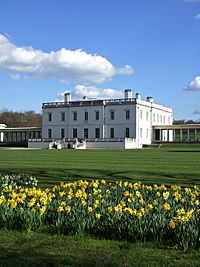Queen's House facts for kids
Quick facts for kids Queen's House |
|
|---|---|

The Queen's House, viewed from the main gate
|
|
| General information | |
| Location | Greenwich London, SE10 United Kingdom |
| Construction started | 1616 |
| Completed | 1635 |
| Client | Anne of Denmark |
| Owner | Royal Museums Greenwich |
| Design and construction | |
| Architect | Inigo Jones |
| Designations | Grade I listed Scheduled monument |
The Queen's House is a famous building in Greenwich, London. It used to be a home for queens, but now it is a public art gallery. The house was built between 1616 and 1635. It stands on the land where the old Greenwich Palace once was.
Today, the Queen's House is a key part of the Old Royal Naval College. It has a grand view that stretches all the way to the River Thames. This area is part of a World Heritage Site called Maritime Greenwich. The architect, Inigo Jones, designed the house for Queen Anne of Denmark. Later, Queen Henrietta Maria also used it. The house was a special place for the queens to relax and show off their art. This includes a famous ceiling painting in the Great Hall by Orazio Gentileschi.
The Queen's House is very important in British architecture. It was the first building in England to be built in the Classical style. This style uses ideas from ancient Greek and Roman buildings. Inigo Jones designed it after traveling to Italy. He studied Roman, Renaissance, and Palladian architecture there. Before this house, English buildings only borrowed small parts of the Classical style. The Queen's House was truly revolutionary for its time. It also features unique parts like the Tulip Stairs and the Great Hall, which is a perfect cube shape.
After being a royal home, the Queen's House became part of the Royal Hospital for Seamen. Its clear view to the river helped shape the design of the hospital buildings. In the 1800s, new parts were added for a school for sailors' children. Today, the house is a Grade I listed building and a scheduled monument. This means it is a very important historical site. The house is now part of the National Maritime Museum. It displays many maritime paintings and portraits.
Contents
Early History of the Queen's House
The Queen's House is located in Greenwich, London. It was built next to the old Tudor Palace of Greenwich. That palace was a large, red-brick building. The new, white Queen's House looked very different next to it. The original idea was for the house to be a pavilion. It would have a bridge over the main road that ran through the palace park.
Building the house started in 1616. But work stopped in 1618 when Queen Anne became ill. She passed away the next year. Work began again in 1629. King Charles I gave the house to his wife, Queen Henrietta Maria. The main structure of the house was finished by 1635.
However, the house was only used by royalty for about seven years. The English Civil War started in 1642. This changed royal life in England. Some of the house's original inside parts still exist. This includes three ceilings and some wall decorations. But none of the interior looks exactly as it did originally.
Many artworks made for the house are now in other places. For example, a ceiling panel by Orazio Gentileschi is now in Marlborough House in London.
Even though it was not used much, the Queen's House was important for the design of Sir Christopher Wren's Greenwich Hospital. Queen Mary II insisted that the view from the Queen's House to the water should not be blocked. This led to the grand layout of the hospital.
Amazing Architecture

Inigo Jones built the Queen's House in the 1600s. It was England's first classical building. Queen Anne of Denmark asked Jones to build this unique house in 1616. When she died in 1619, the house was not finished. Jones completed it for Queen Henrietta Maria in 1635.
The Queen's House looks very different from other English buildings of that time. Jones created a bridge on the first floor that connected the two halves of the building. Inigo Jones was greatly inspired by Italian Renaissance architecture. He especially liked the Palladian style created by Andrea Palladio. Jones used ideas of balance, detail, and good proportions in his design.
Unlike the traditional red-brick Tudor style of the old palace, the Queen's House is white. It is known for its elegant proportions. Jones also used different types of columns. He changed them from Corinthian to Ionic for the finished house.
Inigo Jones's design is famous for two main parts: the Great Hall and the Tulip Staircase. The Great Hall is the most important room in the Queen's House. It has a first-floor gallery that looks down on black and white marble flooring. The Great Hall is special because it is a perfect cube. It measures 40 feet (about 12 meters) in every direction. Jones used Palladio's rules of proportion for this design.
The Tulip Staircase was very unusual for its time. It was the first geometric and unsupported staircase in Britain. It is made of beautiful wrought iron. Each step is held up by the wall and by the step below it. This design was invented by the mason, Nicholas Stone. Jones got the idea for the staircase and the glass roof above it from a monastery in Italy. He liked how staircases with a hole in the middle could get light from above.
Royal Patrons
Queen Anne of Denmark
Anne of Denmark was the wife of King James I of England. She was an important supporter of the arts. Anne asked her frequent helper, Inigo Jones, to work on the Queen's House. Although the house was not finished before her death in 1619, Anne used the palace at Greenwich as her own art gallery. Both King James I and Queen Anne had private art galleries. They used these spaces to show off their wealth and importance. Anne's project might have been influenced by similar buildings in Denmark. Her brother, Christian IV of Denmark, even sent Danish stonemasons to help her at Greenwich.
Queen Henrietta Maria
Henrietta Maria was the wife of King Charles I. She was the daughter-in-law of Anne and James. She took over the rights to Greenwich Park in 1629. She asked Inigo Jones to come back and finish the Queen's House. This happened between about 1629 and 1638. Henrietta was a big supporter of artists. She bought and ordered many artworks for the Queen's House. She used the palace as a "House of Delights." She filled it with amazing art, including the Great Ceiling.
Allegory of Peace and the Arts (Ceiling by Orazio Gentileschi)

Orazio Gentileschi was a favorite artist of King Charles I. Queen Henrietta Maria asked him to decorate her "House of Delights." By the time Gentileschi died in 1639, the Queen's House held about half of his works from England. This included the ceiling of the Great Hall, painted from 1635 to 1638. The main part of this ceiling is a large round painting. It is surrounded by eight other paintings. The ceiling celebrates the rule of King Charles I. It shows how he encouraged peace and the arts. Gentileschi's work also shows the power of women. Almost all of the twenty-six figures on the ceiling are women.
The ceiling has a large round painting in the center. There are four rectangular paintings on each side. Four smaller round paintings are in the corners. The central painting shows Peace floating on a cloud. She is surrounded by figures representing the Liberal Arts, Victory, and Fortune. The other panels show the nine Muses and figures for Painting, Sculpture, Architecture, and Music. The image of Peace holds an olive branch and a staff. This shows that peace comes from good government and learning.
In 1708, Gentileschi's paintings were removed from the Queen's House. Queen Anne gave them to Sarah Churchill. They were put in Marlborough House in London, where you can still see them today.
Recently, another artist worked on the ceiling for the first time since 1639. This was Turner Prize winner, Richard Wright. In 2016, Wright and his team filled the empty spaces on the ceiling. They used gold leaf to create a new design. Wright was inspired by the patterns on the floor and the Tulip Staircase. His new ceiling reflects the house's geometry and beauty.
Building the Greenwich Hospital

The Queen's House survived, but the main palace was slowly taken down between 1660 and 1690. From 1696 to 1751, the Royal Hospital for Seamen was built in its place. This hospital is now called the Old Royal Naval College. The Queen's House was in a specific spot. Queen Mary II wanted it to keep its view of the river. Because of this, the hospital was designed with two matching sets of buildings. They were separated by a grand open space, exactly the width of the Queen's House.
The whole area at Greenwich creates an amazing architectural view. It stretches from the Thames to Greenwich Park. This grand design is one of the main reasons why UNESCO named 'Maritime Greenwich' a World Heritage Site in 1997.
Changes in the 1800s
From 1806, the Queen's House was used as the center of the Royal Hospital School. This school was for the sons of sailors. Because of this new use, more space was needed. New parts were added to the east and west sides of the house. These were connected to the main house by colonnades (rows of columns). These were designed by Daniel Asher Alexander.
In 1933, the school moved to a new location. The Greenwich buildings, including the Queen's House, were then changed and restored. They became the new National Maritime Museum (NMM). The museum was created by law in 1934 and opened in 1937.
In the late 1870s, the land north of the house was rebuilt. This happened after a railway tunnel was built underground. The tunnel was an extension of the London and Greenwich Railway and opened in 1878.

Recent Years and Current Use
In 2012, the area south of the Queen's House was used for the equestrian events of the 2012 Summer Olympics. The house itself was used as a special VIP center for the games.
To get ready for the Olympics, the Queen's House had some internal changes. Work was also done on its lead roof for security and cameras. The house then had a 14-month restoration starting in 2015. It reopened on October 11, 2016. The house had also been restored between 1986 and 1999. Some modern parts were added during that time.
Today, the Queen's House mainly displays the museum's large collection of marine paintings. It also shows portraits from the 1600s to the 1900s. The house is usually open to the public every day, and entry is free. It is part of the National Maritime Museum, which also includes other galleries and the Royal Observatory, Greenwich.
In late 2022, a painting from 1768 by artist Tilly Kettle went on permanent display. This painting shows Sir Samuel Cornish, 1st Baronet, Richard Kempenfelt, and Thomas Parry on HMS Norfolk. The National Maritime Museum bought it with help from the Society for Nautical Research.
See also
 In Spanish: Casa de la Reina (Greenwich) para niños
In Spanish: Casa de la Reina (Greenwich) para niños




